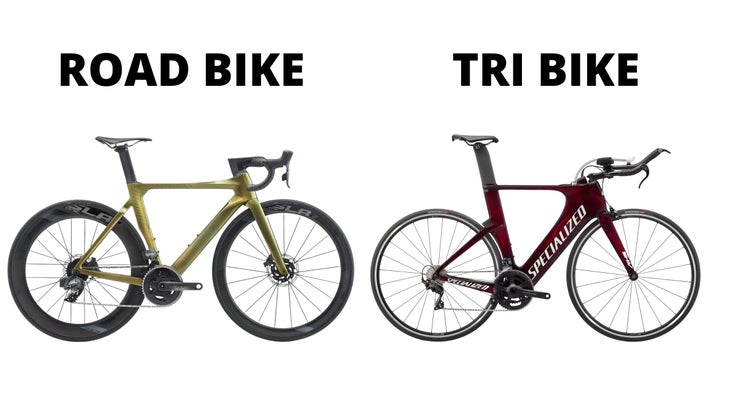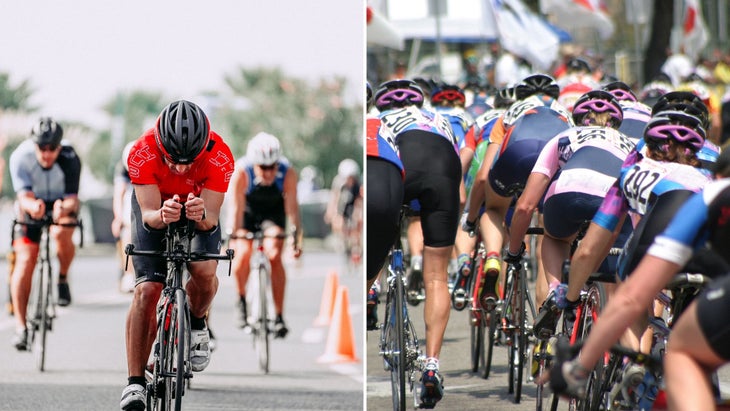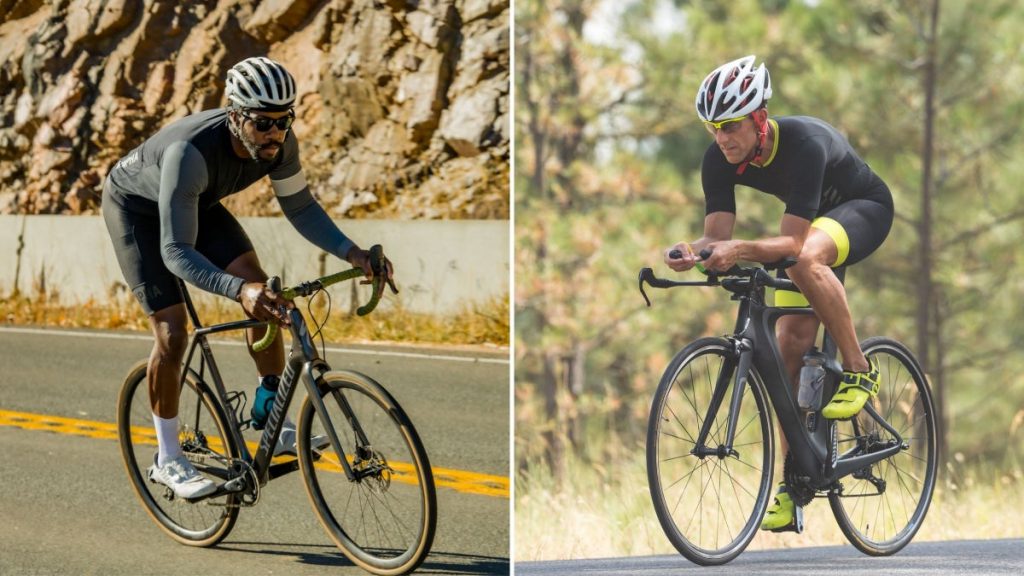If you’re a new triathlete, you might be wondering which is better: a road bike or a triathlon bike. Though many triathletes have strong opinions about the best beginner triathlon bikes, the truth is that you probably don’t need a tri-specific bike for your first race. Any bike is just fine for your first triathlon, whether it’s the mountain bike you already have in your garage or the road bike you’re borrowing from a friend. Your first triathlon should be about having fun and learning the ropes—not about spending money.
But once you’re hooked (and you will get hooked!) after your first race, we can return to the question of road bike versus triathlon bike. Which will be better for you and your preferred style of racing? To get the answer, it’s best to understand the difference between the two.
RELATED: Tri 101: How to Get Started in Triathlon

What
Our entire world has specialized tools: paring knife & cleaver, mini van & coupe, paint brush & roller. So too do road bikes and tri bikes have overlaps and precise advantages.
The handlebars are the most obvious difference between the two. A road bike has the classic “drop bar”and a triathlon bike has a base bar, arm pads, and aero extensions. A closer look at the geometry shows that the road bike frame places the saddle a bit farther behind the pedals and the handlebars a little higher. This gives a road bike rider a better ability to climb steep slopes, descending twisting turns, and create explosive accelerations. The triathlon bike geometry positions the saddle forward, nearly over the pedals, and the bars lower. This gives the tri bike rider a more aerodynamic position to slice through the wind with ease.
A triathlon bike can still climb, descend, corner, and accelerate quickly, but not quite as well as a road bike. That’s because most triathlon courses are flat-ish and straight-ish compared to celebrated road climbs like Alpe d’Huez—which is one reason you don’t typically see aerobars on most stages of the Tour de France.
RELATED: Save Money, Prioritize Your Tri Gear Purchases
Why
The “why” of road bike vs. tri bike design can be boiled down to one word: drag. The road bike leaves the rider higher, hands wider, and more “in the wind” than the tri bike. When properly fitted on a triathlon bike, the rider is tucked up, with narrower hands/elbows/arms and a flatter torso—also known as “aero” position. All of this combines to let the triathlete slip through the wind. The result is faster speed at the same effort.
There’s easy logic behind these differences. Road cycling allows for drafting. The rider in front is doing the lion’s share of the work, while the riders behind are rolling 30% easier by sitting in their wake/out of the wind/in their draft. “Draft-legal” triathlon exists in the Olympics, at national championships, at many amateur races around the world, and is expanding to reach more recreational triathletes. Those events require road bikes. However, the vast majority of age group triathlon is non-drafting and USA Triathlon rules require a 7-meter gap between riders. The triathlon bike provides a position that is far more efficient in non-draft racing.

When and Where
In comparing the use of a road bike or tri bike, the “when” and “where” overlap so beautifully. A triathlete who is racing a non-drafting triathlon should typically be on a tri bike. When racing a draft-legal triathlon (a rare, but growing subset of the sport) athletes must be on a road bike.
There is also a common theory that a technically challenging bike course, one with lots of climbs and descents and sharp turns, would call for a road bike even when it’s a non-drafting race. However, a skilled bike rider can almost always find an advantage in riding a triathlon bike, even on a technically challenging course. Bike skills like cornering, climbing, and descending are important elements in triathlon. They should be prioritized for both safety (in training and racing) and speed. Once cycling competency is achieved a triathlete realizes the value of the aerodynamic position in nearly every race on the planet.
Who
There is a natural progression of bike ownership for most triathletes. When someone enters the sport they typically acquire a road bike, and do a few races on that bike. The next season, it’s common to add a set of clip-on aerobars to the road bike to help reduce their drag and get a bit faster. The road bike isn’t really designed to be ridden like this, but it’s an acceptable half-measure.
Looking to make your road bike work for tri? READ: Your Guide to Setting Up a Road Bike for Triathlon
After a few years, a triathlon bike is commonly acquired, and the athlete has a road bike to use for recovery rides, group rides, super hilly routes. Plus, they can use their triathlon bike for race-specific training in the aero position, typically alone, and at training intensities designed to improve race performance. The more time you spend in the sport, the more you will learn about which bike pairs best with which workout.
Ian Murray is a USA Triathlon Level III Coach, Head Coach of the LA Tri Club and is a Master Bike Fitter.
[ad_2]

